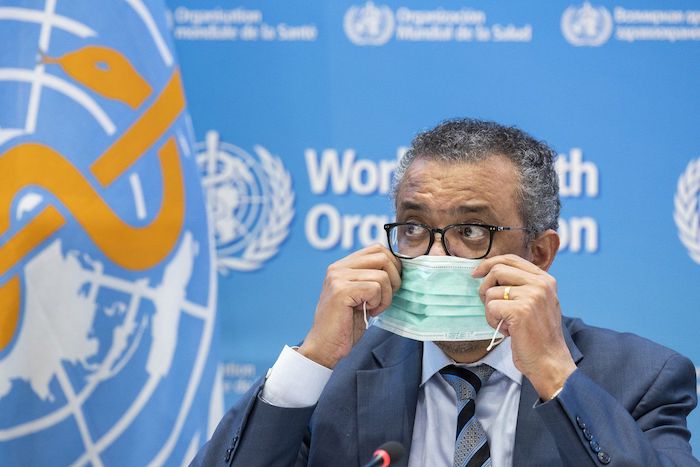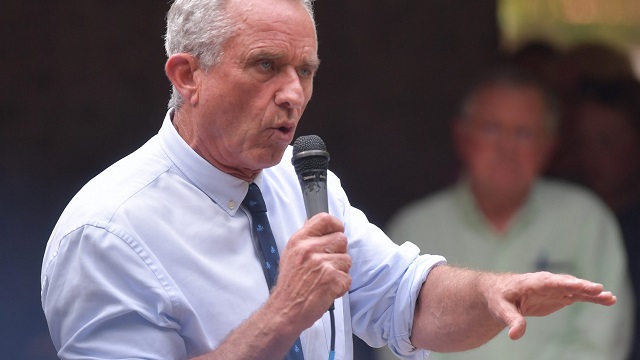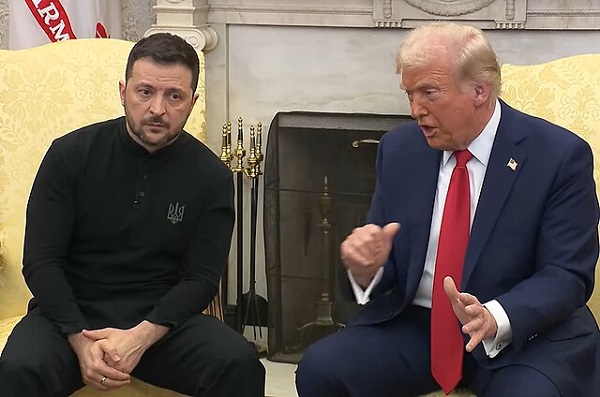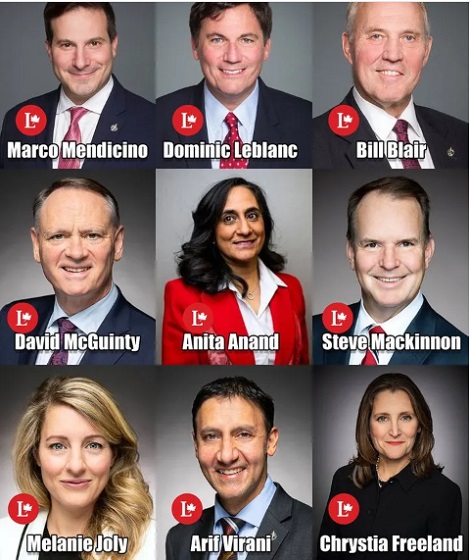Brownstone Institute
Tedros Must Face Reality

From the Brownstone Institute
BY
It would be easier to ignore the World Health Assembly’s (WHA) deliberations in Geneva this week, but the opening address of the Director-General, Tedros Ghebreyesus, deserves a response. Both the WHO and its director are completely divorcing themselves from reality, illustrating how dangerous and unfit for purpose the WHO has become. There is clearly no way that any vote should proceed on anything of importance that the WHO may be required to implement in the coming week of WHA deliberations.
Tedros’s emphasis was on pandemics, and the faltering agreements intended to address their risk, the new Pandemic Agreement, and amendments to the International Health Regulations (IHR). While these are watered down and the Pandemic Agreement may not even get to a vote, his continued justification for centering greater coordination and power at the WHO speaks volumes about the problem we face.
The Covid-19 period has resulted, as Tedros notes in his address, in up to 20 million additional deaths. WHO-supported policies achieved this, for a virus whose mortality mostly occurred in chronically sick people over 75 years of age. The WHO notes that a little over 7 million are directly attributable to the virus. Many of these other 13 million occurred in low- and middle-income countries, in populations where less than 1% of people are over 75 years old and half are under twenty, such as those of sub-Saharan Africa.
This is a staggering, appalling, incompetent, and entirely predictable achievement. However, it is going to get much worse. The policies the WHO promoted closed supply lines, shut down the workplaces of tens of millions of day laborers, stopped travel and tourism income on which millions of low-income people rely, closed markets, and pushed over hundreds of millions into severe poverty. They increased the indebtedness of nations globally, with direct effects on child mortality and the ability to grow future economies.
As predicted by the WHO itself, malaria and tuberculosis deaths have increased, and they will stay higher as the impact of increased poverty bites. Funding for essential sanitation and nutrition programs has dropped as the WHO pushed for a shift in funding to mass vaccination in countries with young populations for a disease of the elderly to which they were already immune, supported with frankly idiotic slogans with more to do with advertising than public health, such as “No one is safe until everyone is safe.”
In closing schools, for up to two years in some countries, the world has cemented in intergenerational poverty and inequality, overwhelmingly harming hundreds of millions of children at most future risk. Child labor has increased, and up to ten million additional girls are being forced into child marriage with the poverty and abuse that entails. When Tedros states in his opening WHA speech that “the whole world was taken hostage,” this should be what he is referring to. The world was taken hostage by the appalling people who took over public health, used the WHO as a tool with its leadership’s consent, and made hundreds of billions of dollars in profit through these harms foisted on others. Indeed, as Tedros notes, “covid has affected everybody.”
Amidst all this rhetoric, the WHO is completely ignoring, and knowingly misrepresenting, what their own data tells them on the risk of natural pandemics. Whilst deliberately misleading countries and the media with claims that the risk of pandemics is rapidly increasing, they are fully aware that deaths from infectious diseases, and pandemics, have decreased over past centuries and are decreasing now. The databases and citations of reports from the WHO, the World Bank, and G20 High Level Independent Panel attest to this.
The causes of infectious disease deaths predominantly revolve around poor nutrition, sanitation, and supply lines for basic medicines. All these, improving before 2020, are now put at risk. Pretending that new diagnostic technologies that allow us to distinguish small virus outbreaks from the declining background constitute increased risk is a public health fallacy that must surely be deliberate. When Tedros states that the drafting teams of the pandemic texts “operated amid a torrent of mis- and disinformation,” he is correct, but it was not from the source he suggests.
So, when we are told that the “world was unprepared” for Covid-19, we should understand that we were unprepared for the hijacking of the WHO and public health policy, not for a virus that had an infection fatality rate in most countries little different than influenza. Pretending that deaths from ‘lockdowns’ were due to Covid adds to the current denial of reality. Lockdown was and should remain a term describing imprisonment. In public health it has been promoted by those who ended up gaining from the Covid debacle; private and corporate funders and their followers. There is a reason why public health previously stressed honest messaging and individual choice.
If the world is to actually address the risk presented by a repeat of Covid, then it had better address its cause – which looks increasingly likely to have been a laboratory leak from gain-of-function research. Nothing in the texts of the proposed Pandemic Agreement or IHR amendments even refers to this. Spending tens of billions per year on a surveillance network for natural threats will impoverish millions and divert funds from diseases of far higher burden, but do nothing to address the problem of research laboratories being paid to enhance virus virulence in humans. The proposed PABS scheme in the Pandemic Agreement in which the WHO will oversee increased passage of pathogens between laboratories and WHO-partnered pharmaceutical companies will likely do more to raise risk than reduce it.
We can all be relieved that the proposed pandemic texts are watered down from their egregious original versions and the Pandemic Agreement is unready for this WHA session. However, any increased coordination of power in the hands of the WHO, in its current state, is dangerous. The world has undergone enough damage in the past four years through misdirection and deliberate misinformation from an international agency that always knew better. Until the root causes of this are addressed, including ever-increasing influence on the organization of private individuals and corporate entities, and the glaring conflicts of interest in related public-private partnerships such as Gavi and CEPI, the world does indeed remain at increasing risk of the repeat of the disaster to which it was recently subjected.
We must first address the reasons why international public health is now about profit and centralization, rather than the health of populations. This won’t happen under the current version of the WHO, and does not appear on the WHA agenda. We are facing a mass denial of reality by the WHO and its leadership. Until this is rectified, any WHA votes that grant further powers or oversight to the WHO are unlikely to be in the interests of the world’s population, or the countries within which they live.
Brownstone Institute
If the President in the White House can’t make changes, who’s in charge?

From the Brownstone Institute
By
Who Controls the Administrative State?
President Trump on March 20, 2025, ordered the following: “The Secretary of Education shall, to the maximum extent appropriate and permitted by law, take all necessary steps to facilitate the closure of the Department of Education.”
That is interesting language: to “take all necessary steps to facilitate the closure” is not the same as closing it. And what is “permitted by law” is precisely what is in dispute.
It is meant to feel like abolition, and the media reported it as such, but it is not even close. This is not Trump’s fault. The supposed authoritarian has his hands tied in many directions, even over agencies he supposedly controls, the actions of which he must ultimately bear responsibility.
The Department of Education is an executive agency, created by Congress in 1979. Trump wants it gone forever. So do his voters. Can he do that? No but can he destaff the place and scatter its functions? No one knows for sure. Who decides? Presumably the highest court, eventually.
How this is decided – whether the president is actually in charge or really just a symbolic figure like the King of Sweden – affects not just this one destructive agency but hundreds more. Indeed, the fate of the whole of freedom and functioning of constitutional republics may depend on the answer.
All burning questions of politics today turn on who or what is in charge of the administrative state. No one knows the answer and this is for a reason. The main functioning of the modern state falls to a beast that does not exist in the Constitution.
The public mind has never had great love for bureaucracies. Consistent with Max Weber’s worry, they have put society in an impenetrable “iron cage” built of bloodless rationalism, needling edicts, corporatist corruption, and never-ending empire-building checked by neither budgetary restraint nor plebiscite.
Today’s full consciousness of the authority and ubiquity of the administrative state is rather new. The term itself is a mouthful and doesn’t come close to describing the breadth and depth of the problem, including its root systems and retail branches. The new awareness is that neither the people nor their elected representatives are really in charge of the regime under which we live, which betrays the whole political promise of the Enlightenment.
This dawning awareness is probably 100 years late. The machinery of what is popularly known as the “deep state” – I’ve argued there are deep, middle, and shallow layers – has been growing in the US since the inception of the civil service in 1883 and thoroughly entrenched over two world wars and countless crises at home and abroad.
The edifice of compulsion and control is indescribably huge. No one can agree precisely on how many agencies there are or how many people work for them, much less how many institutions and individuals work on contract for them, either directly or indirectly. And that is just the public face; the subterranean branch is far more elusive.
The revolt against them all came with the Covid controls, when everyone was surrounded on all sides by forces outside our purview and about which the politicians knew not much at all. Then those same institutional forces appear to be involved in overturning the rule of a very popular politician whom they tried to stop from gaining a second term.
The combination of this series of outrages – what Jefferson in his Declaration called “a long train of abuses and usurpations, pursuing invariably the same Object” – has led to a torrent of awareness. This has translated into political action.
A distinguishing mark of Trump’s second term has been an optically concerted effort, at least initially, to take control of and then curb administrative state power, more so than any executive in living memory. At every step in these efforts, there has been some barrier, even many on all sides.
There are at least 100 legal challenges making their way through courts. District judges are striking down Trump’s ability to fire workers, redirect funding, curb responsibilities, and otherwise change the way they do business.
Even the signature early achievement of DOGE – the shuttering of USAID – has been stopped by a judge with an attempt to reverse it. A judge has even dared tell the Trump administration who it can and cannot hire at USAID.
Not a day goes by when the New York Times does not manufacture some maudlin defense of the put-upon minions of the tax-funded managerial class. In this worldview, the agencies are always right, whereas any elected or appointed person seeking to rein them in or terminate them is attacking the public interest.
After all, as it turns out, legacy media and the administrative state have worked together for at least a century to cobble together what was conventionally called “the news.” Where would the NYT or the whole legacy media otherwise be?
So ferocious has been the pushback against even the paltry successes and often cosmetic reforms of MAGA/MAHA/DOGE that vigilantes have engaged in terrorism against Teslas and their owners. Not even returning astronauts from being “lost in space” has redeemed Elon Musk from the wrath of the ruling class. Hating him and his companies is the “new thing” for NPCs, on a long list that began with masks, shots, supporting Ukraine, and surgical rights for gender dysphoria.
What is really at stake, more so than any issue in American life (and this applies to states around the world) – far more than any ideological battles over left and right, red and blue, or race and class – is the status, power, and security of the administrative state itself and all its works.
We claim to support democracy yet all the while, empires of command-and-control have arisen among us. The victims have only one mechanism available to fight back: the vote. Can that work? We do not yet know. This question will likely be decided by the highest court.
All of which is awkward. It is impossible to get around this US government organizational chart. All but a handful of agencies live under the category of the executive branch. Article 2, Section 1, says: “The executive Power shall be vested in a President of the United States of America.”

Does the president control the whole of the executive branch in a meaningful way? One would think so. It’s impossible to understand how it could be otherwise. The chief executive is…the chief executive. He is held responsible for what these agencies do – we certainly blasted away at the Trump administration in the first term for everything that happened under his watch. In that case, and if the buck really does stop at the Oval Office desk, the president must have some modicum of control beyond the ability to tag a marionette to get the best parking spot at the agency.
What is the alternative to presidential oversight and management of the agencies listed in this branch of government? They run themselves? That claim means nothing in practice.
For an agency to be deemed “independent” turns out to mean codependency with the industries regulated, subsidized, penalized, or otherwise impacted by its operations. HUD does housing development, FDA does pharmaceuticals, DOA does farming, DOL does unions, DOE does oil and turbines, DOD does tanks and bombs, FAA does airlines, and so on It goes forever.
That’s what “independence” means in practice: total acquiescence to industrial cartels, trade groups, and behind-the-scenes systems of payola, blackmail, and graft, while the powerless among the people live with the results. This much we have learned and cannot unlearn.
That is precisely the problem that cries out for a solution. The solution of elections seems reasonable only if the people we elected actually have the authority over the thing they seek to reform.
There are criticisms of the idea of executive control of executive agencies, which is really nothing other than the system the Founders established.
First, conceding more power to the president raises fears that he will behave like a dictator, a fear that is legitimate. Partisan supporters of Trump won’t be happy when the precedent is cited to reverse Trump’s political priorities and the agencies turn on red-state voters in revenge.
That problem is solved by dismantling agency power itself, which, interestingly, is mostly what Trump’s executive orders have sought to achieve and which the courts and media have worked to stop.
Second, one worries about the return of the “spoils system,” the supposedly corrupt system by which the president hands out favors to friends in the form of emoluments, a practice the establishment of the civil service was supposed to stop.
In reality, the new system of the early 20th century fixed nothing but only added another layer, a permanent ruling class to participate more fully in a new type of spoils system that operated now under the cloak of science and efficiency.
Honestly, can we really compare the petty thievery of Tammany Hall to the global depredations of USAID?
Third, it is said that presidential control of agencies threatens to erode checks and balances. The obvious response is the organizational chart above. That happened long ago as Congress created and funded agency after agency from the Wilson to the Biden administration, all under executive control.
Congress perhaps wanted the administrative state to be an unannounced and unaccountable fourth branch, but nothing in the founding documents created or imagined such a thing.
If you are worried about being dominated and destroyed by a ravenous beast, the best approach is not to adopt one, feed it to adulthood, train it to attack and eat people, and then unleash it.
The Covid years taught us to fear the power of the agencies and those who control them not just nationally but globally. The question now is two-fold: what can be done about it and how to get from here to there?
Trump’s executive order on the Department of Education illustrates the point precisely. His administration is so uncertain of what it does and can control, even of agencies that are wholly executive agencies, listed clearly under the heading of executive agencies, that it has to dodge and weave practical and legal barriers and land mines, even in its own supposed executive pronouncements, even to urge what might amount to be minor reforms.
Whoever is in charge of such a system, it is clearly not the people.
Brownstone Institute
Hysteria over Robert F. Kennedy Jr.’s Promise to Make Vaccines Safer

From the Brownstone Institute
By
“People are reacting because they hear things about me that aren’t true, characterizations of things I have said that are simply not true. When they hear what I have to say, actually, about vaccines, everybody supports it.”
Robert F. Kennedy, Jr. has been confirmed as Secretary of the US Department of Health and Human Services.
Within hours, my news feed was populated with angsty articles hand-wringing about the future of vaccines under Kennedy, whom legacy media and the establishment are certain would confiscate life-saving vaccine programs, raising the spectre of mass waves of illness and death.
In particular, this quote from Senator Mitch McConnell (R-KY), the only Republican who voted against Kennedy’s confirmation, appeared over and over again:
“I’m a survivor of childhood polio. In my lifetime, I’ve watched vaccines save millions of lives from devastating diseases across America and around the world. I will not condone the re-litigation of proven cures, and neither will millions of Americans who credit their survival and quality of life to scientific miracles.”
Yet, I could not find one piece of mainstream coverage of this quote that mentioned the astonishing fact that 98% of polio cases in 2023, the most recent year for which we have full data, were caused by the polio vaccine.
You read that correctly. In 2023, 12 wild polio cases were recorded (six in Afghanistan, six in Pakistan), with a further 524 circulating vaccine-derived cases, mostly throughout Africa. This trend is in keeping with data from the previous several years.
An important contextualising detail, wouldn’t you think?

The cause of this polio resurgence is that the world’s poor are given the oral polio vaccine (OPV), which contains a weakened virus that can replicate in the gut and spread in feces, causing vaccine-derived outbreaks.
People in rich countries get the inactivated polio vaccine (IPV), which does not contain live virus and therefore does not carry the risk of spreading the very disease it’s vaccinating against.
The World Health Organization (WHO) and vaccine-promoting organisations say that the way out of the problem is to vaccinate harder, as the argument goes that outbreaks only occur in under-vaccinated communities.
This may be well and good, but the total omission of the fact from media coverage that the goalposts have shifted from eradicating wild polio (not yet complete but nearly there, according to the WHO) to eradicating vaccine-derived polio (the main problem these days) underscores that this is why hardly anyone who knows anything trusts the media anymore.
A member of my extended family has polio. It’s nasty and life-altering and I wouldn’t wish it on anyone.
That’s why I would hope that any vaccines given would be safe – contracting polio from the supposedly preventative vaccine is the worst-case scenario, second only to death.
This is Kennedy’s expressly stated aim.
“When people actually hear what I think about vaccines, which is common sense, which is vaccines should be tested, they should be safe, everyone should have informed consent,” he said at his confirmation press conference.
“People are reacting because they hear things about me that aren’t true, characterisations of things I have said that are simply not true.
“When they hear what I have to say, actually, about vaccines, everybody supports it.”
Grown-ups who support vaccines can walk and chew gum. From the point of view of the public health establishment, the polio vaccine has prevented millions of cases and has nearly eradicated the disease.
At the same time, the world’s poorest are afflicted with polio outbreaks which we can work to prevent, and the safety of all polio vaccine products on the market should be subject to the rigorous standards applied to all other medicines.
Unless you think that poor people don’t matter, in which case the status quo might suit you fine.
Republished from the author’s Substack
-

 2025 Federal Election2 days ago
2025 Federal Election2 days agoTrump Has Driven Canadians Crazy. This Is How Crazy.
-

 2025 Federal Election1 day ago
2025 Federal Election1 day agoPoilievre Campaigning To Build A Canadian Economic Fortress
-

 Automotive1 day ago
Automotive1 day agoCanadians’ Interest in Buying an EV Falls for Third Year in a Row
-

 conflict2 days ago
conflict2 days agoTrump tells Zelensky: Accept peace or risk ‘losing the whole country’
-

 armed forces17 hours ago
armed forces17 hours agoYet another struggling soldier says Veteran Affairs Canada offered him euthanasia
-

 conflict16 hours ago
conflict16 hours agoWhy are the globalists so opposed to Trump’s efforts to make peace in Ukraine?
-

 2025 Federal Election2 days ago
2025 Federal Election2 days agoCarney Liberals pledge to follow ‘gender-based goals analysis’ in all government policy
-

 2025 Federal Election2 days ago
2025 Federal Election2 days agoPoilievre’s Conservatives promise to repeal policy allowing male criminals in female jails










